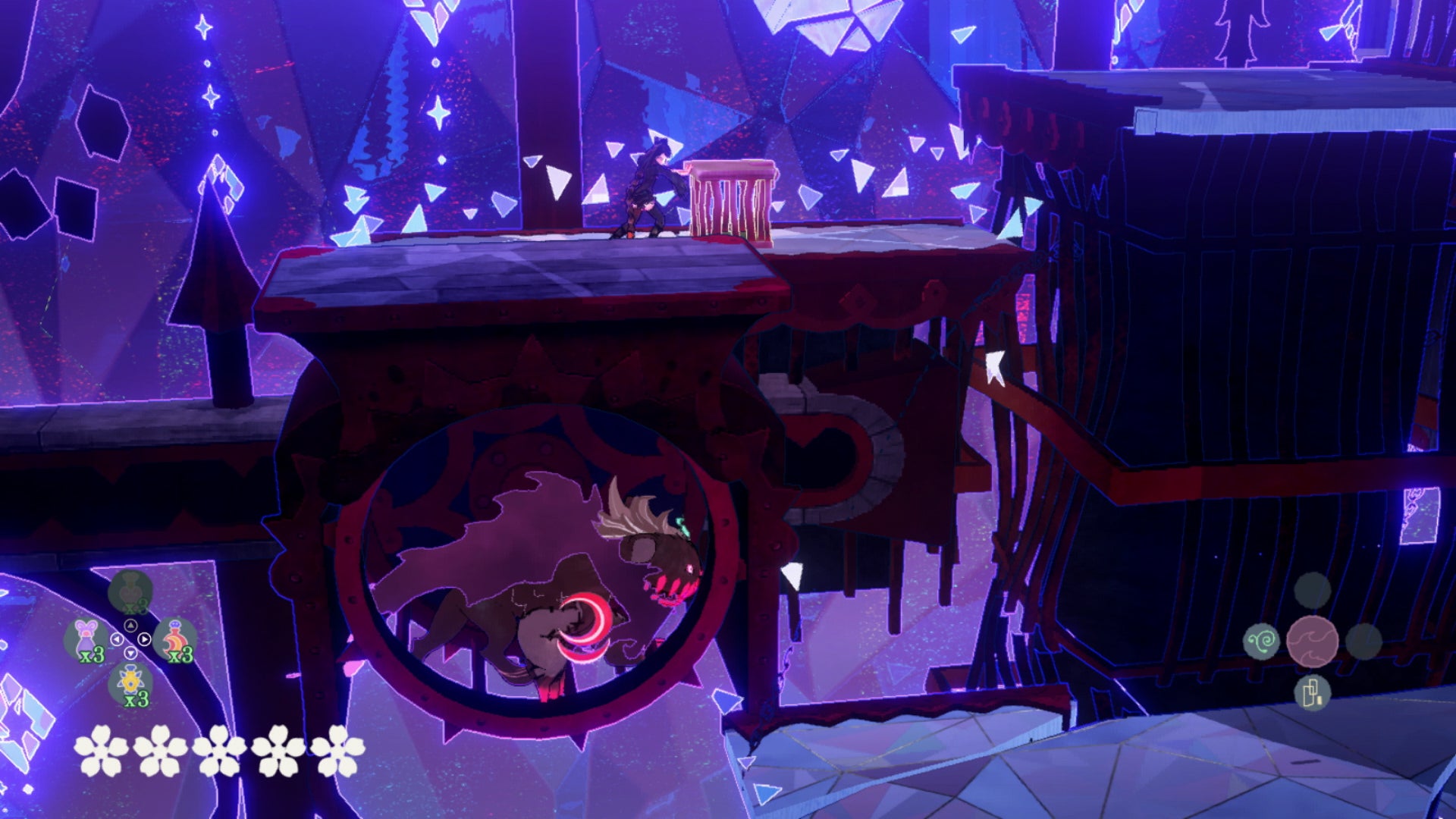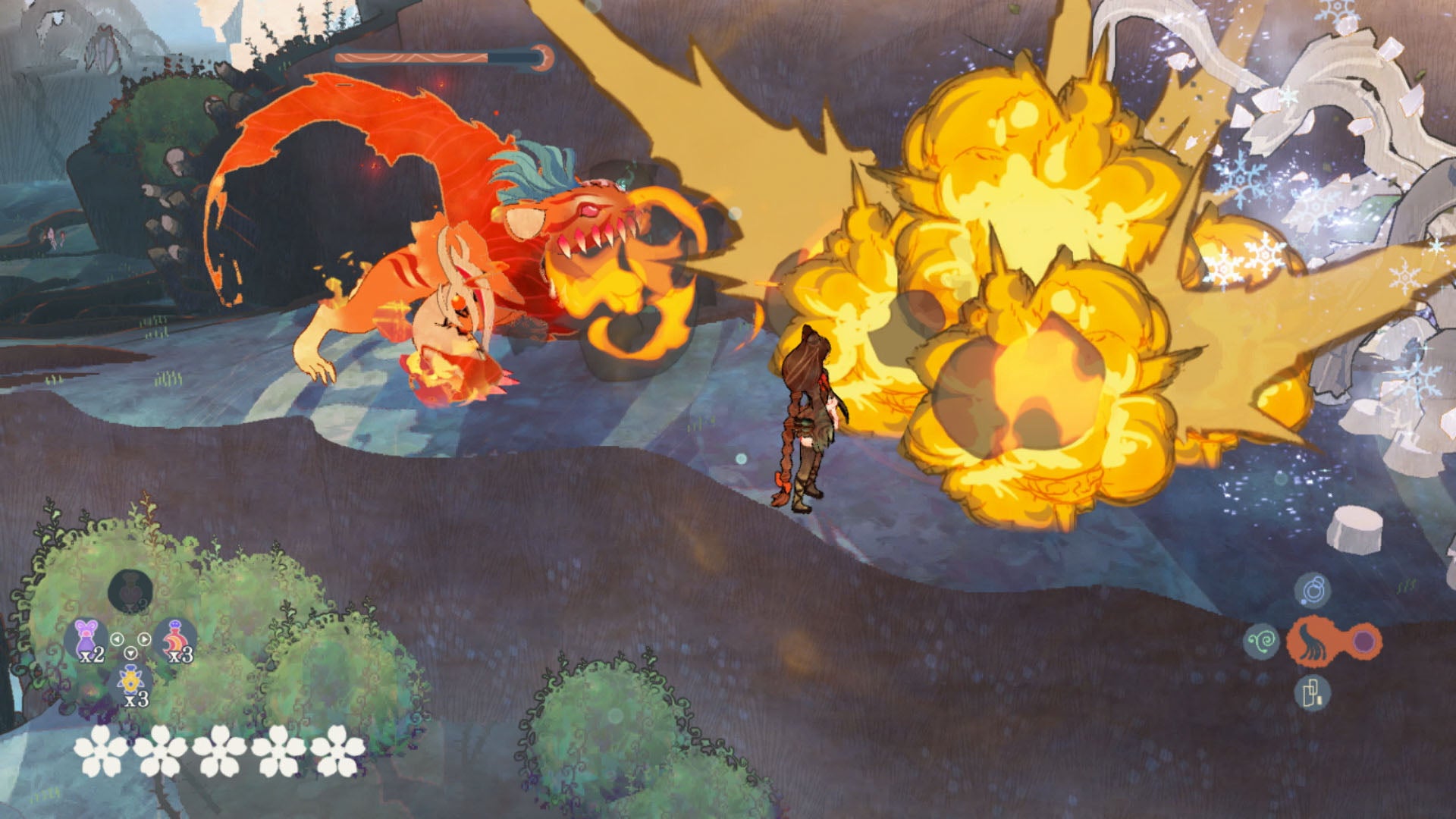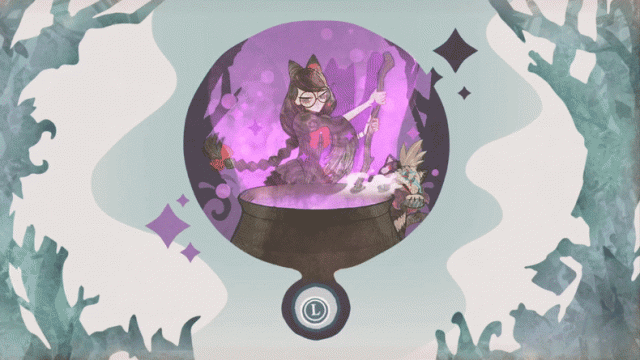After suffering my way through Bayonetta 3’s final act, I’d all but written off any subsequent Bayonetta video game and moved on to greener character-action game pastures. While I still stand by the closing statement in my review that I’ll never replay Bayonetta 3 ever again, PlatinumGames’ prequel spin-off game, Cereza and the Lost Demon (which released for Nintendo Switch on March 17), has convinced me to leave my heart and wallet open for future Bayonetta games of this quality.
Read More: Bayonetta 3: The Kotaku Review
As much as I wanted to dislike Cereza for being the “we’re sorry” game after Bayonetta 3, I was disarmed by how charming and relaxing its art style, dialogue, and gameplay mechanics are.
Cereza is the sweetest chaser PlatinumGames could’ve given me after the sour shot Bayonetta 3 left in my mouth.
Cereza and the Lost Demon follows a young Cereza (Bayonetta’s government name) during her witch training. Unlike her confident adult self, little Cereza is hapless at best when it comes to magic. After a chance encounter with a mysterious child (who totally isn’t the game’s big bad), Cereza decides to explore a faerie forest for a power-up that’ll allow her to free her incarcerated mother, Rosa.
Despite the game being developed alongside Bayonetta 3, Cereza feels like PlatinumGames’ “in case of emergency, break glass” title to get back into fan’s good graces after Bayonetta 3’s ending. Fortunately, Cereza manages to clear this hurdle with its impressive art direction and engrossing puzzles, and has me wanting more low-stake games within the Bayonetta universe.
Cereza pays homage to Okami, but it’s still unique

Similarly to how Bayonetta 3 felt like the devs flipped the script after playing Devil May Cry 5 halfway through its development, the opening moments of Cereza feel like PlatinumGames copying Capcom’s homework with Okami — a 2006 action-adventure series the Bayonetta games have unabashedly referenced in the past.
Unlike Bayo 3‘s lifting of DMC5’s major story beats, Cereza’s utilization of Okami’s painterly art style doesn’t clash with the tone of the game’s story and combat. Much like Okami’s art direction utilises heavy brush strokes and water-coloured demons and allies to accentuate the game’s calligraphy-esque combat, Cereza’s art direction neatly encapsulates the splendor and menace of Bayonetta’s universe through a young witch’s eyes.
Instead of taking on the fleshy avant-garde aesthetic of the Bayonetta series’ infernal demons, every thorny enemy and hulking eldritch horror you encounter is oddly pleasing to look at in Cereza’s cutesy art style. Even the game’s potion crafting, demonography, and chapter selection menu screens feel like leafing through a painterly Little Golden Books version of Bayonetta.
Cereza is as much the Okami-fication of the Bayonetta series’ aesthetic as a Kirby-fication of its combat. While none of the puzzles or combat arenas stump me or require an “easy mode is now selectable” difficulty slider, that doesn’t stop Cereza’s gameplay from being enthralling. Gameplay-wise, L and ZL are your Umbran witch Swiss army knife here. Aside from serving as your environmental interaction button, these buttons also trigger Cereza’s Umbran dance, allowing her to create platforms, bloom power-granting plants, and summon demons.
And just when Cereza feels like it’s about to bore me with breezy gameplay mechanics, the game expands upon its combat and exploration with her demonic familiar, Cheshire.
While Cereza occupies the left hand shoulder buttons, Cheshire occupies the right. In what I can only compare to grabbing the thumbsticks of your friend’s controller and moving both your characters in tandem with one another, Cereza has you control both characters while exploring the faerie forest. This is where the game has me sitting forward in my chair because its gameplay is basically a wicked version of It Takes Two: You control both characters instead of playing co-op.
There are some circumstances where Cereza and Cheshire can’t walk the same paths, leaving you to problem-solve environmental puzzles to reunite them. There are two methods for doing this: Hug and Unleash Mode. In Hug Mode, Cereza can use Cheshire’s doll form to slingshot herself across platforms and toss him to higher ledges to traverse different paths. By using Unleash Mode, Cereza can freeze enemies while hacking and slashing them in his demonic form.
Who is Cereza for exactly?

The glaring question I have in the back of my mind while playing Cereza and the Lost Demon is: Who exactly is this game for? The last thing a Bayonetta fan wants — especially one who loves the series’ penchant for bitrate crashing setpieces, naughty braggadocious quips, and hyperactive combat — is a game with simplified platforming, PG dialogue, and “easy” combat.
The closest thing I can come up with to justify Cereza’s existence is that it services lore-hungry fans with nuggets of information that expand Bayonetta’s universe. As opposed to other games infodumping the bulk of its lore in codex entries and droves of mind-numbingly convoluted exposition by its undercooked villains, Cereza lets you take in information alongside Cereza and Cheshire. It explains concepts like the importance of a witch’s hair as a vessel for demons and demonstrates that importance repeatedly through its many platforming and hack-and-slash moments. Seemingly insignificant facts like rosemary serving as demon repellant in the Bayonetta series play a big role in Cereza as environmental obstacles to overcome. But even lore fiends like myself won’t find much more to chew on with this easier-to-follow entry into the series — because there’s no choice meat on its bones.
From the jump, Cereza’s quest to save her mother is an, um, interesting plot choice because the course of the Bayonetta series dictates that her mother will die, regardless of the universe she finds herself in. This fact, which was tiresomely exacerbated in Bayo 3, makes any investment in her daring adventure feel pointless before it even begins.
Let her cook! Witch-in-training Cereza is brewing up potions to help in her journey through Avalon Forest in #BayonettaOrigins: Cereza and the Lost Demon. pic.twitter.com/WCXLlz9R8U
— Nintendo of America (@NintendoAmerica) March 20, 2023
To make up for the bookended circumstances of the Bayonetta series story, Cereza lures players in by dropping scenes with lil Jeanne, info on how faeries — which were introduced in Bayo 3 — fit within the pantheon of otherworldly creatures, and introducing new characters like Cereza’s mentor and Umbran witch outcast Morgana to keep fans fed. While these additions are bewitching on their own, none of them feel compelling or special enough to warrant the release of a prequel Bayonetta game.
But as is the case with most Bayonetta games, Cereza’s story, which is arguably one of the better ones by virtue of how comprehensible it is, plays second fiddle to its enthralling gameplay loop — which slaps.
The Bayonetta series still has baggage
Cereza’s release comes at an awkward juncture in the series, where fans are wondering if they should play future Bayonetta games. Last November, series creator Hideki Kamiya announced on Twitter that Bayonetta 4 was in development and will address the previous game’s contentious ending in “unexpected” ways. In a follow-up tweet, Kamiya likened fans who disliked Bayo 3 to “maddened poisonous radio transmitter[s]” that should steer clear of any future entries in the series.
it would be cool if they made a game about bayonetta from bayonetta origins where she is all grown up and has gun shoes and could fight stuff https://t.co/mpKBfRodVC
— zac (@3amsoda) March 19, 2023
Read More: Bayonetta Creator Shares His Two Cents On Fan Outrage Over Bayonetta 3’s Ending
But despite the real-world baggage of the Bayonetta series’ and the bookended nature of its storyline, Cereza and the Lost Demon is a lot of fun to play. Ultimately, Cereza still can’t shake the feeling that its release smacks of the same kind of “striking while the iron is cold” corporate decision-making the Marvel Cinematic Universe made when it released an uninspired Black Widow prequel film after the cataclysmic events of Avengers: End Game. Thankfully, unlike the roller coaster superhero flick, Cereza and the Lost Demon isn’t creatively bankrupt and serves as a much-needed palette cleanser from Bayonetta 3’s wet fart of an ending.

Leave a Reply